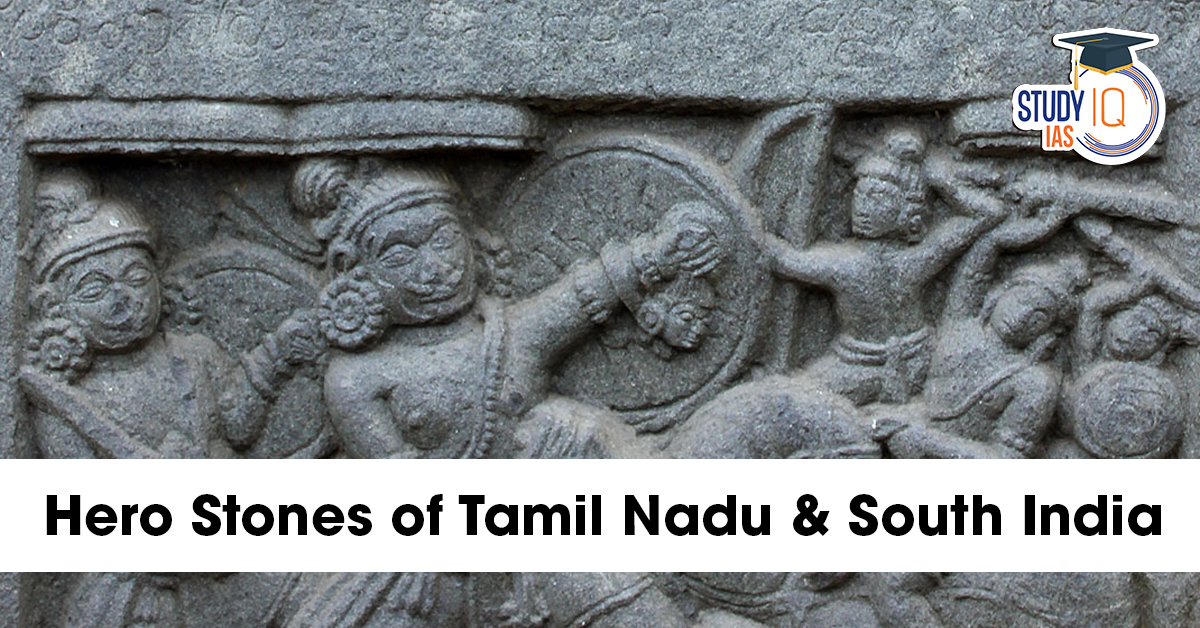Table of Contents
Hero Stones, known as Nāṭukkal in Tamil and Vīragallu in Kannada, are ancient memorial stones erected to honor individuals who laid down their lives in acts of bravery. Unlike royal monuments or temple inscriptions, these stones reflect a grassroots tradition of valor, commemorating common people who sacrificed themselves to protect cattle, land, or their community. Found across Tamil Nadu, Karnataka, Andhra Pradesh, Kerala, and even in Sri Lanka, these relics offer a unique insight into India’s subaltern history and folk memory.
What Are Hero Stones (Nāṭukkal)?
Hero Stones are memorials carved out of local stone, erected by communities to remember ordinary people, including men, women, families, and even animals, who performed heroic acts. These are non-royal commemorations, deeply rooted in social ethics, community honor, and cultural values.
Geographical Spread
Hero Stones are widely distributed across:
-
Tamil Nadu
-
Karnataka
-
Andhra Pradesh & Telangana
-
Kerala & Puducherry
-
Lakshadweep & Sri Lanka
Material Used:
These stones are made using locally available stones, not ornamental ones like marble or granite, emphasizing folk aesthetics and accessibility.
Chronology and Historical Phases
| Phase | Period | Features |
|---|---|---|
| Early | 3rd BCE – 5th CE | Symbols like shields, cattle, urns; no human figures. |
| Middle | 6th – 9th CE | Human depictions emerge; scenes of cattle raids and warfare. |
| Later | 10th CE onwards | Sati memorials, saints, and ascetics added. |
| Colonial | 18th CE onward | Decline due to loss of ritual culture and colonial changes. |
Why Were Hero Stones Erected?
Common Reasons:
-
Dying while protecting cattle, village land, or community honor.
-
Commemorating non-elite warriors.
-
Honoring women who committed Sati.
-
Rare cases include animals like dogs and roosters, and even a selfless thief.
Underlying Philosophy:
-
Heroism was about self-sacrifice, not conquest.
-
The memory belonged to people, not to temples or kings.
-
These stones symbolized moral universality—anyone could be a hero.
Cultural and Literary Roots
The ethics behind Hero Stones can be traced to Sangam literature:
-
Puranānūru, Akanānūru, and Pathitrupathu celebrate heroic sacrifice.
-
These texts prescribed rituals for erecting Nāṭukkal.
-
Introduced the ideal of Tīmaṉ—the selfless guardian of the community.
Ritual and Social Function
Hero Stones were not merely decorative:
-
Placed at village borders, water tanks, crossroads, and fields.
-
Served as protective symbols (Kaval Deivam).
-
Adorned with peacock feathers and worshipped during local feasts.
-
Played an active role in village identity and seasonal traditions.
Linguistic and Epigraphic Importance
Unlike royal inscriptions written in Sanskrit or Prakrit, Hero Stones showcase:
-
A linguistic journey: Brahmi → Vatteluttu → Modern Tamil.
-
Reflect local dialects and oral traditions.
-
Provide insights into the evolution of regional scripts and languages.
Archaeological Significance
Hero Stones are crucial sources for understanding:
-
Weaponry, attire, and warfare tactics.
-
Cattle economy and village disputes.
-
Funerary rituals and grassroots historical memory.
They are a form of subaltern archive—preserving history from below.
Why Did Hero Stones Decline?
During the colonial period, the erection of Hero Stones declined due to:
-
Suppression of folk and ritual traditions.
-
Shift toward modern legal systems and centralized historical narratives.
-
Loss of community-centric religious practices.
Modern Revival and Documentation Efforts
Today, the Tamil Nadu Government, along with NGOs like Yaakkai Heritage Trust, is:
-
Geotagging and digitally documenting Hero Stones.
-
Recognizing them as part of India’s intangible cultural heritage.
-
Aiming to preserve rural memory and educate future generations.
Summary of Significance
| Aspect | Importance |
|---|---|
| Sociological | Democratizes history by honoring commoners. |
| Cultural | Embeds Sangam-era ethics into village rituals. |
| Epigraphic | Reflects regional scripts and dialect evolution. |
| Archaeological | Reveals grassroots practices and rural economy. |
| Historical | Offers a counter-narrative to elite-centric history. |
Conclusion
Hero Stones are not just relics—they are powerful symbols of collective memory, moral duty, and folk identity. They remind us that history isn’t only made by kings or empires, but also by ordinary people whose acts of courage shaped their communities. As India revives its rich intangible heritage, Hero Stones stand tall—testaments to valor, sacrifice, and the enduring spirit of the people.


 World Summit on Disaster Management (WSD...
World Summit on Disaster Management (WSD...
 Domestic Systemically Important Banks (D...
Domestic Systemically Important Banks (D...
 The Missing Link in India’s Critical M...
The Missing Link in India’s Critical M...

























